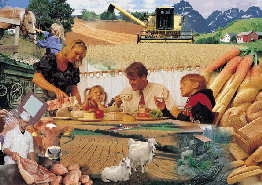Agricultural policy in Norway
Historical archive
Published under: Bondevik's 1st Government
Publisher: Ministry of Agriculture
Guidelines/brochures | Date: 11/02/2000
AGRICULTURAL POLICY IN NORWAY
The multifunctionality of Norwegian agriculture is ensured through a combination of economic, legislative and administrative measures, as well as through training and extension. In 1997, total transfers associated with agricultural policies amounted to US $3 billion. Net budgetary outlays amounted to US $1.7 billion and, thus, accounted for 57% of the transfers, while transfers from consumers through border protection accounted for 43%. Blue Box measures (primarily acreage and livestock support) represent approximately 60% of budgetary outlays, while Green Box measures amount to around one third. AMS policies, basically, account for the remaining budgetary support.
 Important
parts of the agricultural policy is laid down in the Agricultural
Agreement, negotiated between the farmers' organisations and the
Government and approved by the Parliament. Support and protection
measures in the agricultural sector are not primarily based on
income considerations, but aim first and foremost at ensuring a
sufficient level of public goods, such as food security, viability
of rural areas and environmental protection, demanded by the
Norwegian society.
Important
parts of the agricultural policy is laid down in the Agricultural
Agreement, negotiated between the farmers' organisations and the
Government and approved by the Parliament. Support and protection
measures in the agricultural sector are not primarily based on
income considerations, but aim first and foremost at ensuring a
sufficient level of public goods, such as food security, viability
of rural areas and environmental protection, demanded by the
Norwegian society.